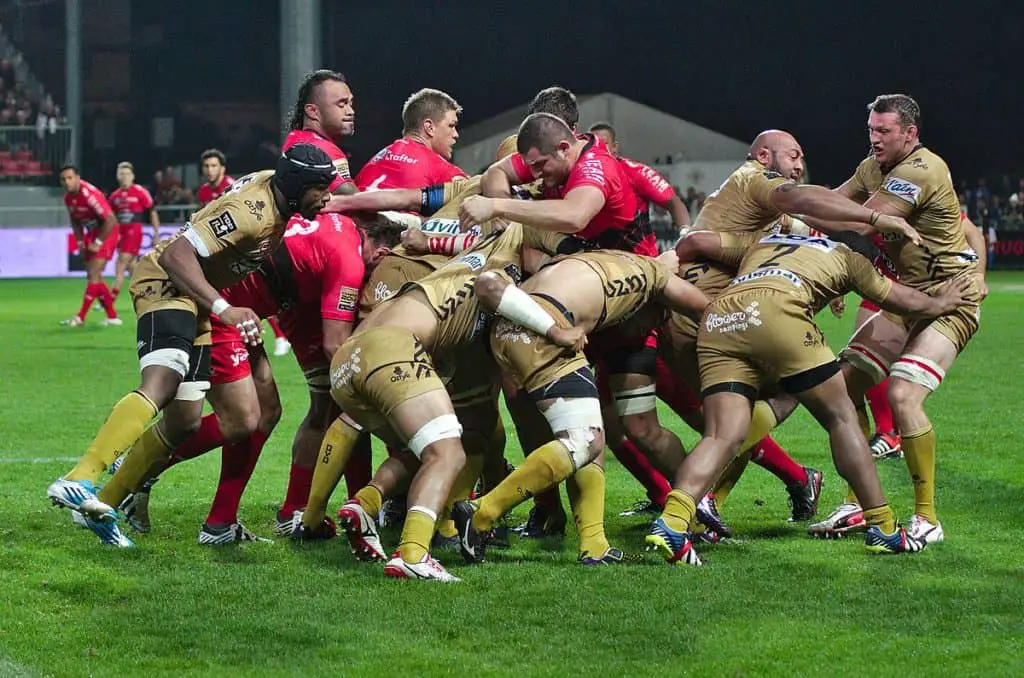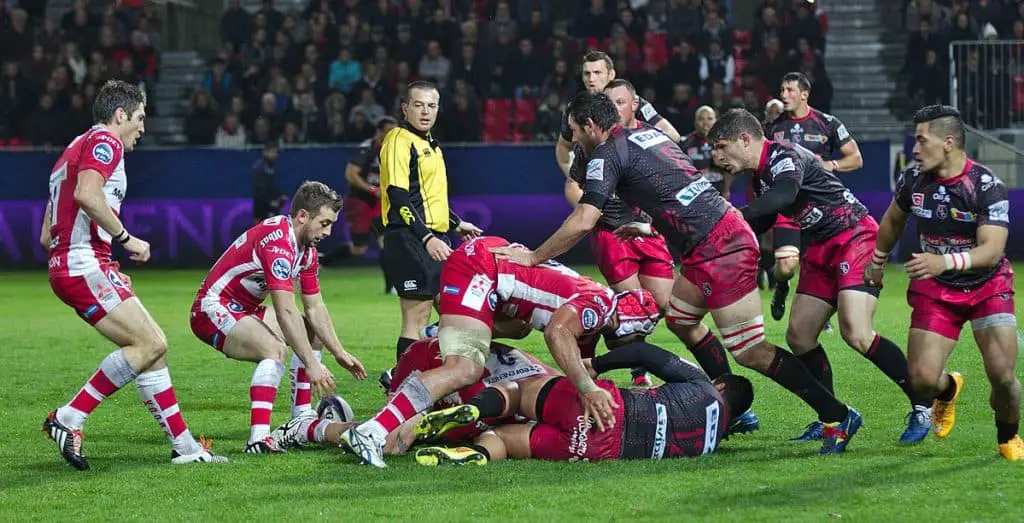Loved and loathed in equal measure, mauls in rugby are a crucial part of the game. Whilst they can look ungainly, they require a good deal of team work, co-ordination and a surprisingly high degree of fitness.
Mauls in rugby union allow players to compete for the ball when a tackle occurs and the tackled player remains on their feet. A minimum of three players are involved: the tackler, tackled player and one more player from either side.
The maul must always be moving towards one side or the other’s goal line. If it remains static for more than 5 seconds then the side who took the ball into the maul hand the ball over to the opposition for a scrum.
In a maul players have to join from the hindmost foot and bind to a teammate. Deliberately collapsing the maul or pulling opponents out of the maul will result in conceding a penalty.
A maul also creates an offside line at the hindmost foot of the maul which players not involved in the maul must remain behind or risk conceding a penalty.
How many times can a maul stop in rugby?
Once a maul starts moving it is allowed to stop and restart once. If it restarts and stops a second time the ball must be used within 5 seconds or a scrum will be awarded to the team without the ball.
The referee will shout out clearly ‘once’ the first time they considerthe maul to have stopped, and then ‘twice’ the second time it stops. After this they will shout ‘use it or lose it‘.
The attacking team then has to pass the ball away, or run the ball away from the maul. If they do not then the opposition will get the put in to a scrum but in reality this never happens as the team will use the ball.
You might want to read: Basic Rules of the Scrum (Explainer)
How do you win a maul in rugby?
A maul is won when either the defending team prevents the opponents from releasing the ball from the maul, or when the attacking team has driven the maul as far as they wish and move the ball away from it to attack elsewhere.
Whether you are trying to attack or defend using the rolling maul, body position and communication are key.
The ideal body position is as low as possible with the back parallel to the ground and the touchline. Arms should be bound tightly around teammates either side, or in front ensuring everyone’s force is driving in the same direction.
Feet should take short powerful steps in effect pumping the feet into the ground ideally in unison with teammates. This is why you will often hear players shouting ‘one, two, one two’, or something similar to try and get everyone working at the same time.
The ball carrier should keep the ball secure, usually tucked under one arm with the other arm bound to another player near the back of the maul. They should carry it in such a position so that the scrum-half can take it at any time they see fit.
If they are close to the opposition’s try line the player at the back may opt to keep the ball in with the hope that the maul will cross the line and they can drop to the ground and score a try.
On the other hand, the defending team can try to encircle and ensnare the ball carrier so that they cannot release it to any teammate. This would mean that the referee would see that the ball is not going to come out of the maul and the ball would be handed to the defending team in the form of a scrum.
Another option is for the defending team to simply not allow the maul to move forwards. This would force them to pass the ball away in a much slower manner than if the maul was moving forwards. The defensive line would not be moving backwards and so this could cut down the attacking backs’ space more quickly.
You might like to read: Penalties and Free-kicks in Rugby: A Basic Guide
Can you collapse a maul in rugby?
You are not allowed to collapse a maul in rugby union. If you do then the referee will award a penalty against you and may issue a yellow card dependent upon the situation of the game.
In reality, teams do collapse mauls if they feel that conceding a penalty is better than conceding a try and possibly having a player yellow carded.
What does ‘rolling maul’ mean?
A rolling maul is when the attacking team rotates the maul one way so that opposing defenders cannot push directly back and instead fall off to the side. The ball carrier and a few teammates can then continue the maul with fewer defenders pushing against them.
Note how in the picture below the yellow team have successfully rolled the maul and there are now no defenders in front of the ball carrier, the perfect outcome.

This slow rotation of the maul is very difficult to defend as defending players essentially get spat out to the side and they then have to run backwards in order to rejoin the maul and try and stop this.
Even if the defenders do get enough players back to stop the maul, the attacking team can simply repeat the same process, rolling the maul to the side and gaining momentum again.
Some teams get so good at this that it becomes their primary weapon. It does not matter if their opponents know they are going to do it as it is simply very hard to stop a rolling maul without giving away a penalty.
Suggested for you: Can You Get Up After Being Tackled In Rugby?
What is a Rugby ‘lineout maul’?
A maul that forms directly after a lineout throw in has been caught is called a lineout maul, or a catch and drive. Typically once the lineout jumper catches the ball the props will guard them on either side and the rest of the forwards will fall in behind and drive this platform forwards.
Lineout mauls can be performed anywhere on the pitch but are often done close to the opponents try line if they feel they have the physical power to drive their opponents over.
The only real way to combat a lineout maul is to either compete for the ball in the air and try and steal it before they get started, or don’t try and compete for the ball but just get everybody ready to hit the catcher as hard as they can when they do land.
If a maul does get moving then very often the only real way to stop it is to tackle one of the front players and make the maul collapse which is not allowed. The result of this will be a penalty and possible conceding three points.
However, three points is better than seven and so teams often do this. Referees will start to give warnings and then yellow cards to players doing this in order to ensure future mauls aren’t collapsed in the same way.
Rugby maul vs Ruck (Differences Explained)
A maul occurs when a player is tackled but stays on their feet and a third player other than the tackler, or tackled player joins the wrestle for the ball. A ruck occurs when the tackled player goes to ground and a player from either side comes in to compete for that ball over the top of the player.

Rucks tend to create quicker ball for a team, i.e. the ball comes out of a ruck faster and it can then be passed out to the backs quicker (see picture above).
This decreased time to get the ball out to the backs is important as the defending team has had less time to set their defense and so there may be more gaps to run into for attackers.
On the other hand, mauls tend to produce much slower ball for the backs which means they are often running against defenses which are much better organized.
Mauls do have the advantage, however, that they can draw in more players who might be trying to stop the maul moving forward. This is useful as the more defenders join the maul the more space there will be elsewhere on the pitch for the backs to run into.
There are lots of other reasons why team might deliberately try to create a ruck or maul in particular. If a team is fitter than their opponents then they will want to play a faster rucking game.
However, if a team is bigger and more physical then they will much prefer a mauling game which will involve less running and more physical wrestling instead.
Recommended for you: Basic Rules of the Lineout and How They Work?
Image Credits
Rolling maul: 3 October 2014, 20:52:55 Clément Bucco-Lechat, CC BY-SA 3.0, via Wikimedia Commons
Gloucester Rugby – 20141025 – Maul Clément Bucco-Lechat, CC BY-SA 3.0, via Wikimedia Commons
Gloucester rugby ruck Clément Bucco-Lechat, CC BY-SA 3.0, via Wikimedia Commons
